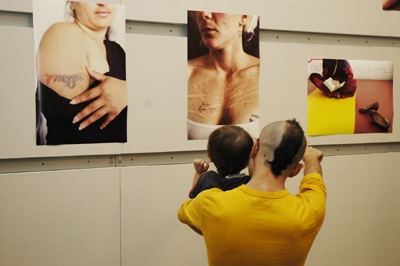Guerrilla Girls-Identities
6th october> 4th november 2007
Monsummano Terme, Macn, Villa Renatico Martini
Understanding sexual difference as a “cultural” datum can be considered like the big bet of the feminist movements. This is also at rock bottom of the work of Guerrilla Girls, the memorable New York group of women artists founded in 1985 which, within Networking 2007, presents the first anthology of their work in Italy. The exhibition, set up in the spaces of Macn in Monsummano Terme, is a double event which includes the collective exhibition Identities with works by the young artists of Networking.
Sexual difference is first of all gender difference which creates different levels of social exclusion. It is in fact starting with the exhibition An International Survey of Painting and Sculpture set up at the MoMA of New York in 1985 with only 13 female artists out of 169, that a group of women artists decided to leave their own personal identity to found the Guerrilla Girls group. Since then the aim of the work is the charge of sexist discrimination in the world of art, of politics, of cinema, etc. Appearing in public always under gorilla’ s mask and taking as first names those of feminist artists of the past, Guerrilla Girls charges, with hundreds of posters made, a system which promises parity of the sexes but hardly allows it. Campaigns of public attachments, demonstrations, sit-in of protest were some of the instruments used to bring the attention of the media and of the art world on an unacceptable situation of discrimination. The exhibition retraces all the main stages of this path by now part of the art history of the 20th century bringing it closer as model and prototype of action to the work of a group of young Italian artists at present in force. In this way the fight of Guerrilla Girls for the statement of a gender identity not discriminated connects itself to the multiple forms of social action and of possible identity building which the exhibition Identities presents. Identities, in the plural, because these works and the identities which they build do not accept to shut within enclosures but they consider themselves rather like possible signatures of belonging to be built. Thus, the work Family portrait by Arianna Subri created a photographic studio set up along the cavalcade of the Family Day in Rome in 2007 and at the very same time of the lay counterdemonstration in Piazza Navona. |
Many of the participants along the two cavalcades did the models for a “family portrait”. The series of portraits made presents a family configuration different each time but united by a common category of belonging, the family, each time the same and different in the manifold individual configurations. An idea of belonging which can also become constrictive like in the video work Let me get what I want by Filippo di Del Bubba recorded during the gay pride 2007 in Rome, in which the desire of exit from the stereotypes and of statement of the self takes the shape of the emotional narration. Identity as obligation is present also in the work of Antonella Piga Con-fine, a photographic work carried out in the women and underage branch of the Sollicciano penitentiary. A course which brought the artist to be witness and interpreter of denied identities and forced within a total institution like the penitentiary, but still in search of possible communication spaces. But identity is usually a process of change of the self, a horizon towards which to aim like in the short film Palo by Pasquale Scalzi and Armando Sanna and in the work Ellis Island by Anonymous Art Studio. It was the passage island of the Italian migrants to enter the United States. A form of national belonging which Margherita Isola declines in its complexity in the work Leisure status: the Italian flag becomes a pillow on which it is embroidered a rebus about the different identities being a woman in Italy, flag accompanied by a remix of the La gazza ladra by Rossini performed by a contemporary musician. The semantic and symbolic complexity emerges also in the photographic series Orifizi made in studio by Virginia Panichi concerning the symbols of femininity and in the performance Dirty with sweetness made for the opening by Schejla Massellucci on the symbols, often easily judged, of the Islamic woman. Reconsidering one’s own role means also reconsidering one’s own expectations within a determined field of social action; Margherita Isola welcomed the audience during the opening on her knees holding a placard on which there was written: Be happy please. A wish, this is true, but also a course to be taken, reconsidering oneself like Rachel Morellet began to do through the performance-embroidery Embroidery: typical male accomplishments. Made during 21 days of penis envy . |






